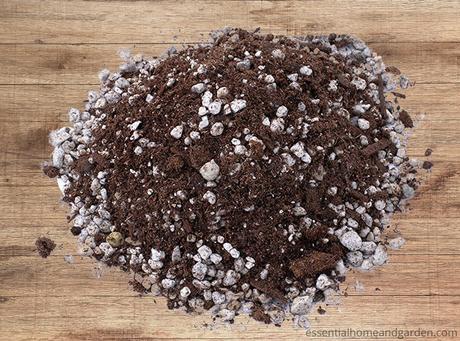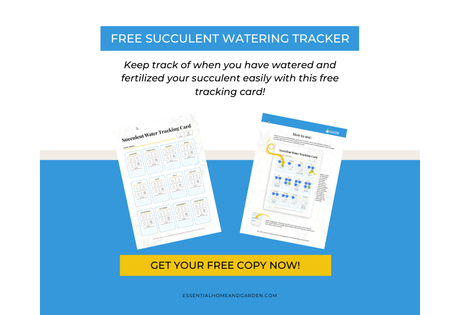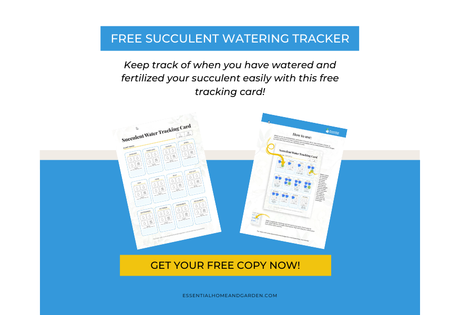Succulents are supposed to be so easy to grow that anyone can do it. But if you've killed a succulent with root rot or let it dehydrate to a crisp, you aren't the only one.
Watering succulents isn't as easy as it seems because they do not drink water the same as most other plants. Luckily, you can learn to properly water your fleshly beauties and give them a long and happy life.

How to Water Succulents
Correctly watering your succulents will ensure they grow slowly and steadily. Overwatering can cause succulents to grow too quickly and become deformed. It can also cause root rot, bacterial and fungal problems and put the plant at greater risk of opportunistic pests.
Watering Succulent Plants Indoors
There are two excellent techniques for watering succulents properly. And, both of these methods require a pot with a drainage hole in the bottom. The key is that you imitate the natural habitat where succulents thrive. Specifically, you need to allow the soil to dry out completely in between thorough waterings, mimicking a dry climate with occasional torrential storms.
Soak and Dry Method
- Place the pot in your sink.
- Gently water the plant until water streams out the bottom.
- After the initial watering, leave the pot sitting in the sink for a minute or more. This resting time allows the water to absorb throughout the soil via wicking.
- Then, you should drench the soil with water a second time to make sure the potting mix is completely saturated.
- After the double-soaking, leave the pot in the sink for a while to drain all excess water.
- Move the plant back to its home only after it has stopped dripping to avoid accumulating water in the pot's saucer.
- Let the potting mix dry thoroughly before watering again.
Dunk and Soak Method
Some plants are difficult to water using the soak and dry method - if you have a large succulent or grouping of succulents that fills the top of the pot. In that case, you can use the "dunk and soak" method instead.
- As always, start by confirming that the soil is fully dry before watering.
- Prepare a bucket or basin of water. You will only need several inches of water, not a full bucket.
Note: The container needs to have a larger diameter than your pot, but it does not need to be as tall as your pot.
- Carefully lower your potted plant into the bucket and set it down, making sure the displaced water does not rise high enough to touch the plant or flow over the top edge of the pot. If the water level is too high, remove some before setting down your pot.
- Leave the plant in the water to soak and draw water up through the drain hole. If you have good soil in the pot, the soil will wick the water upward to saturate all the potting soil gradually. If you're using an unglazed ceramic pot, the pot will also absorb water.
Depending on the size of the pot, the size and number of holes in the pot, and the quality of the soil, it may take only a few minutes to saturate the soil, or it may take quite a bit longer.
Note: Do not leave the pot in the bucket after the soil is saturated; Leaving the pot underwater for too long can drown your plant's roots.
- When the soil has fully saturated, carefully lift the pot out of the bucket. Allow it to drain in a sink, or empty the bucket and put the pot back into the bucket to drain.
You should only return it to the saucer after the pot is fully drained. You can check the saucer a little later in the day to make sure no water has accumulated.
Watering Outdoor Succulents
How you care for outdoor succulents depends on whether they are potted or planted directly in the ground. Either way, remember that watering succulents should be on an as-needed basis.
Note: Rainfall is often more than enough to keep succulents hydrated for most of the year.
Outdoor Potted Succulents
When watering outdoor potted succulents, you can use the same watering methods as for indoor potted succulents. For the soak and dry method, you can just use a hose. If the pot is on a saucer, don't forget that you should empty the saucer after watering.
Outdoor In-ground Succulents
Watering in-ground succulents is easier. Most of the year you won't need to water at all. In warmer, drier seasons, simply wait until you are sure that the ground is dry, then soak the soil around the plant using a hose.
To ensure the water fully saturates the soil, use a slow hose or a soaker hose or irrigation system, but let them run for an extended time. To set yourself up for success, make sure you only plant outdoor succulents that can thrive in your growing zone. That means using plants that can tolerate your temperature range and the amount of rainfall you can expect each year. Unless you live in Zone 9+, you will be best off limiting yourself to cold-hardy succulents.
Track Your Watering
You can always use a traditional calendar but consider a succulent-specific watering tracker. Water on an as-needed basis, and each time you do it, use a sticker, stamp, or marker to record it on the tracking card template we've created below. Don't forget to mark the card when you fertilize as well.

Note: Make notes, as needed, to remind yourself of when the plant's dormancy period began and ended and changes you want to make to the plant's care routine next year, for example.
Keep a separate tracking card for each succulent. From year to year, you'll gather enough information that will help you refine your succulent-care routine.
If you prefer being reminded electronically, you can try using apps like Succulent Tracker or Gardenia, which help you schedule watering, fertilizing, and other plant care based on the species.
Create A Proper Growing Environment
Watering is essential, but if you're using the wrong sort of pot or soil, the game is rigged against you. Follow these guidelines to create a healthy growing environment.
For even more advice about propagating, planting, and feeding your succulents, you can check out our how-to guide.
Soil Type is Important

How frequently you'll need to water your succulent needs depends on the quality of the soil. Dense soil full of organic matter and clay will retain water for a longer time, encouraging rot. Your succulent will be much happier if grown in loose, well-draining soil.
Most succulents grow in soil full of sand or gravel in the wild. Some even grow in little rocky crevices in cliff-sides. In other words, you want to focus more on drainage than on organic matter.
However, the scarcity of organic matter in a good succulent mix means you should make sure to fertilize or repot your succulents frequently. This way, the organic matter available to the plant is rich in nutrients.
This commercially available gritty mix designed for succulents looks like it's mostly rock, but it is made of calcinated clay and pine bark. It is ideal for succulents, but it is more expensive than other types of potting soil.
Rather than purchasing a succulent-specific mix, you can mix your own by combining equal parts of cactus potting mix and a coarse amendment, such as perlite, volcanic rock such as pumice, small pebbles, or gravel, bark chips, small pieces of broken pots, etc.
Info: Cactus potting mix is typically high in substances like coir, so it drains well, especially when adding a coarse amendment.
If you don't have access to cactus mix, you can achieve something similar using regular potting soil. You should mix equal parts of ordinary potting soil with sharp sand. Then, mix it with 50/50 with your coarse amendment. Keep in mind that you should avoid using potting soils that include moisture-retaining amendments like vermiculite.
Most succulents prefer slightly acidic soil, with a pH of around 6. However, a few grow naturally in soil containing a lot of limestones, which makes the soil more alkaline. It is good to research the type of succulents to confirm their soil pH preference. If you have an acid-loving succulent, check out this article on buying or making acidic potting soil.

Avoid Unnecessary Materials in Pot
Many house plant enthusiasts have mistaken beliefs about how to create good drainage. For example, there is a common myth that a thick layer of gravel or broken pottery pieces in the bottom of your pot will improve drainage. This is untrue.
In actuality, creating an area in the bottom of the pot with big gaps traps water in those gaps, especially if the rocks block the drainage hole in the pot. These pockets of water prevent the soil in the pot from draining and drying, encouraging rot. If you want to use gravel or similar materials, they should be mixed in with the soil.
Make Sure Your Pot Has a Drainage Hole
Yes, it is always better to use a pot with a drainage hole. Our recommended watering techniques are not possible in a pot without a hole. But to be perfectly honest, most gardeners have a beloved pot with no hole that we can't resist using. One option is to drill a hole in the pot.
You can also use a snug-fitting plastic pot inside the solid-bottomed pot. Before watering, you should remove the plastic pot from the larger pot and ensure it is completely drained before returning it to the pot.
If you use a pot with no holes, you will need to be incredibly attentive to your plant. You need to understand how heavy the pot should be - both when it is dry and immediately after a watering session. This way, you only water enough to create a moist but not soggy interior. You will also need to be on the lookout for the earliest signs of under or over-watering. If you struggle with succulents, it's easier just to use a pot with a hole.
How Often Should You Water a Succulent?
There is no single answer to how often you should water your succulents - it depends on the type. Some are thirstier, while others have a brief or long winter dormancy.
Note: Some succulents have a summer dormancy period - typically when certain plants are exposed to over 85 degrees Fahrenheit each day.
The room temperature and humidity have a substantial effect as well. A succulent kept in a cool, humid room will need much less water than a succulent grown in arid conditions.
If you need a general rule to start with, try once a month during the winter. In spring and fall, water once every three weeks. During summer, you can water once every two weeks. However, it is much better to simply water your succulent on an as-needed basis throughout the year - being attentive to your plant, and understanding its needs, is a much better way to judge when water is really needed.
How Do You Know When a Succulent Needs Water?
This is a difficult question to answer because most of the ways you can assess your plant are somewhat subjective. However, there are a few good ways of deciding when your succulent needs more water.
Finger Test
One easy technique to determine if your plant's soil has dried out is to feel the soil. Poke your index finger into the soil on the top of the pot. Many guides will tell you that if your plant is bone-dry down to the depth of your first knuckle, roughly one inch, your plant is ready for water.
Note: Don't water yet if the top of the soil is slightly damp. That means the soil lower in the pot is still wet.
If the soil in the bottom of the pot is compacted, it can stay wet in the bottom while the top is fully dry. A good strategy for avoiding this problem is to repot your plant every 2-3 years using fresh, appropriate soil. Again, knowing your soil is well-draining will ensure the finger test is reliable.
Weight Test
You can accurately judge your plant's dryness better when you know what the pot feels like, in terms of weight, when it is dry. The best way to figure that out is when repotting your plant.
After removing the plant and soil from the pot and cleaning it, refill it with a dry potting mix. Then, lift the pot using both hands and feel how it weighs totally dry. Before you water it, pick it up again. Again, get a sense of the total weight.
Note: You can use a kitchen scale for more accurate weight measurement.
You have your benchmark once you know what the pot feels like or weighs when fully dry. Don't water the plant again until it is close to the original dry weight.
Wilt Test
A final option for deciding when to water is simply observing the plant itself. Some of the tell-tale signs of a succulent that needs water include leaves beginning to shrivel up or wrinkle (becoming deflated rather than fleshy), leaves near the base of the plant drying up to the point of browning, and excessive corking.
Info: Succulents store water in their stems and leaves.
If your succulents show any signs of wrinkling, you should water them at that point.

Common Mistakes People Make When Watering Succulent Plants
Overwatering
Along with inadequate sunlight, overwatering is a prevalent cause of failing succulents because it contributes directly to bacterial or fungal infections and infestation by pests like fungus gnats or aphids.
Info: Avoiding overwatering will prevent most diseases and pests in succulents.
It can be easy to mistake symptoms of overwatering and underwatering. Both can cause normally firm, fleshy leaves to become saggy and soft. Both can also kill off the leaves closest to the base of the plant.
However, underwatering results in the base leaves becoming medium brown and crispy to the touch, whereas overwatering results in dark brown to black and soggy leaves.
Overwatered succulents tend to look semi-translucent. Its leaves are also prone to falling off the plant when you touch it. On the other hand, leaves that have shriveled due to underwatering will still look fully opaque.
If you grow your succulent in a pot with a hole, you should fill it with appropriate soil and allow the soil to dry out completely between waterings.
Drowning the Roots
Overwatering isn't always a result of watering too often or excessively. It can also result from trapping water in the pot.
If you fully saturate a plant's soil in a pot with no hole and don't drain it, you are essentially trying to grow a plant in a full bathtub.
Info: Plants breathe through their roots. When fully immersed in water, plants can't breathe the air they need.
If you keep your succulents in a pot with holes, there is also a chance that you could be unknowingly drowning the roots - especially if you are watering the plant while it is on its saucer or returning the plant to its saucer immediately before allowing it to drain.
This is because excess water accumulates in the saucer, drowning the lowest roots in the pot. It also prevents the soil in the bottom of the pot from drying out between waterings, which encourages rot.
You can avoid this problem by using our recommended watering techniques mentioned above. Don't forget to check the saucer after each watering.
Maintaining Consistent Dampness or Humidity
One of the biggest mistakes you can make with your succulent is treating it like other house plants, such as orchids. They have thick, fleshy leaves that can resemble the leaves of some succulents. They also love loose, well-draining soil. Some people assume they have similar care needs, but the opposite is true.
Info: Orchids come from humid jungle-like environments, while succulents are related to cacti.
Orchids prefer constantly damp soil. They also thrive when misted and kept humid. On the other hand, most succulents want to be completely dry in between waterings and do not need any extra humidity in the air.
That means you should water your succulents on an as-needed basis. There are a lot of automated drip irrigation systems for watering your houseplants while you are on vacation.
These systems typically maintain steadily damp soil. This works great for most houseplants, but not succulents - they hate constant damp soil. Plus, indoor succulents can typically be left to fend for themselves for a couple of weeks at a time.
Watering houseplants isn't most people's idea of a fun time, so it's easy to rush it and water sloppily. The problem is getting your succulents wet above the soil level can be very harmful to the plant - all succulents prefer dry leaves.
This is most important for plants (such as the zebra haworthia) with nested leaves growing from a central crown. In these plants, water dripped on the leaves will tend to slide down into the plant's crown, where lack of air circulation slows evaporation.
Note: Repeatedly trapping water in the base of the plant is a good way to end up with a rotten succulent.
That means you should be careful not to splash the plant when watering. You should dry off any leaves that accidentally get wet. It's also best to water in the morning - the daytime heat will help evaporate any remaining water.
Cut and Dry Strategies for Succulent Care
The bottom line is that the best succulent care isn't based on a schedule - it's based on careful observation and understanding of your plant, its growing environment, and its specific needs. Befriend your succulent and cater to its needs, and you'll enjoy a long and beautiful friendship.

